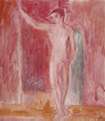 |

|
Solitude |
|
 |
In the course of the 1930s, it was
not only a proposal of formal innovation that united Sassu, Luigi Grosso, Giacomo Manzů,
and Renato Birolli, but also an interest in the evolution of the political, moral, and
ideological situation of Italy. They were joined after 1933 by Fiorenzo Tomea and the
students of Aldo Carpi who had just finished their studies at the Brera academy: Arnaldo
Badodi, Giuseppe Migneco, Italo Valenti. Thus
there formed a first aggregation of what would soon become, between 1938 and 1943, the
Corrente movement. A shared desire for a cultural openness toward what was happening in
Europe, in contrast to Fascism, attracted artists and intellectuals of various backgrounds
to the biweekly Vita giovanile, founded by Ernesto Treccani in January 1938, later
called Corrente di vita giovanile and finally Corrente.
From the artistic point of view there emerged a search for a
more politically and socially committed art, which moved away from the antihistoricism of
celebratory art and the decadentism of art for art’s sake. The forced closing of the
magazine by Fascist authorities on 10 June 1940 coincided with Italy’s entrance into
the war, but the group continued its activity in the gallery Bottega degli Artisti for
another year. |

